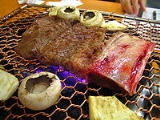
List of Korean dishes
Encyclopedia
Royal court dishes
-
- GujeolpanGujeolpanGujeolpan refers to either an elaborate Korean dish consisting of nine different foods assorted on a wooden plate with nine divided sections in an octagon shape or the plate itself. The name is composed of three hanja words: gu , jeol , and pan in Korean...
(구절판): literally "nine-sectioned plate", this elaborate dish consists of a number of different vegetables and meats served with thin pancakes. It is served usually at special occasions such as weddings, and is associated with royalty. - SinseolloSinseolloSinseollo or yeolguja tang is an elaborate dish consisting of meatballs, small and round jeonyueo , mushrooms, and vegetables cooked in a rich broth in Korean royal court cuisine. The dish is a form of jeongol...
(신선로): An elaborate dish of meat and vegetables cooked in a rich broth. It is served in a large silver vessel with a hole in the center, where hot embers are placed to keep the dish hot throughout the meal.
- Gujeolpan
Grilled dishes
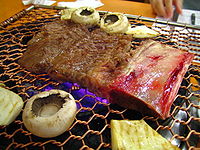
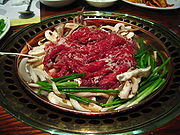
- BulgogiBulgogiBulgogi is a Korean dish that usually consists of marinated barbecued beef, although chicken or pork may also be used. It is listed at number 23 on World's 50 most delicious foods readers' poll complied by CNN Go in 2011.-Etymology:...
(불고기) - thinly sliced or shredded beefBeefBeef is the culinary name for meat from bovines, especially domestic cattle. Beef can be harvested from cows, bulls, heifers or steers. It is one of the principal meats used in the cuisine of the Middle East , Australia, Argentina, Brazil, Europe and the United States, and is also important in...
marinated in soy sauceSoy sauceSoy sauce is a condiment produced by fermenting soybeans with Aspergillus oryzae or Aspergillus sojae molds, along with water and salt...
, sesame oilSesame oilSesame oil is an edible vegetable oil derived from sesame seeds. Besides being used as a cooking oil in South India, it is often used as a flavor enhancer in Chinese, Japanese, Korean, and to a lesser extent Southeast Asian cuisine.The oil from the nutrient rich seed is popular in alternative...
, garlic, sugar, scallionScallionScallions , are the edible plants of various Allium species, all of which are "onion-like", having hollow green leaves and lacking a fully developed root bulb.-Etymology:The words...
s, and black pepper, cooked on a grill (sometimes at the table). Bulgogi literally means "fire meat." Variations include pork (dwaeji bulgogi, 돼지불고기), chicken (dak bulgogi 닭불고기), or squid (ojingeo bulgogi, 오징어불고기). - GalbiGalbiGalbi or kalbi generally refers to a variety of gui or grilled dishes in Korean cuisine that is made with marinated beef short ribs in a ganjang-based sauce . In the Korean language, galbi literally means "rib" and can often indicate uncooked ribs...
(갈비) - pork or beef ribs, cooked on a metal plate over charcoal in the centre of the table. The meat is sliced thicker than bulgogi. It is often called "Korean barbecueKorean barbecueKorean barbecue, or gogi gui literally "meat + roasted meat", refers to the Korean method of grilling beef, pork, chicken, or other types of meat. Such dishes are often prepared at the diner's table on gas or charcoal grills that are built into the center of the table itself...
" along with bulgogi, and can be seasoned or unseasoned. A variation using seasoned chicken is called dak galbi. - SamgyeopsalSamgyeopsalSamgyeopsal is a popular Korean dish. Commonly served as an evening meal, it consists of thick, fatty slices of pork belly meat . The meat, usually neither marinated nor seasoned, is cooked on a grill at the diners' table...
(삼겹살) - unseasoned pork belly, served in the same fashion as galbi. Sometimes cooked on a grill with kimchi together at either side. Commonly grilled with garlic and onions, dipped in sesame oil and salt mixture and wrapped with ssamjang in lettuce . - Makchang gui (막창구이) - grilled pork large intestines prepared like samgyeopsal and galbi, and often served with a light doenjang sauce and chopped scallions. It is very popular in DaeguDaeguDaegu , also known as Taegu, and officially the Daegu Metropolitan City, is a city in South Korea, the fourth largest after Seoul, Busan, and Incheon, and the third largest metropolitan area in the country with over 2.5 million residents. The city is the capital and principal city of the...
and the surrounding GyeongsangGyeongsangGyeongsang was one of the eight provinces of Korea during the Joseon Dynasty. Gyeongsang was located in the southeast of Korea....
region. - Gobchang gui (곱창구이) - similar to makchang except prepared from the small intestinesChitterlingsChitterlings are the intestines of a pig, although cattle and other animals' intestines are similarly used, that have been prepared as food. In various countries across the world, such food is prepared and eaten either as part of a daily diet, or at special events, holidays or religious...
of pork (or ox) - Saengseon gui (생선구이) - grilled fish
- Seokhwa gui or jogae gui (석화구이 or 조개구이) - grilled shellfish
- Deodeok gui (더덕구이) - grilled deodeok (CodonopsisCodonopsisCodonopsis is a genus of flowering plant within the family Campanulaceae. It is allied to Campanumoea and Leptocodon, and some authors suggest that Codonopsis should include these genera...
lanceolata; 더덕) roots - Beoseot gui (버섯구이) - grilled any kind of mushroom
- Gim gui or guun gim (김구이 or 구운 김) - grilled dry laver(or gim)
Steamed dishes
- GalbijjimGalbijjimGalbijjim or kalbijjim is a variety of jjim or Korean steamed dish made with galbi . Beef galbi is sometimes referred to as "gari" , so the dish can be called "garijjim". Galbijjim is generally made with beef or pork short ribs. In the latter case, it is called dweji galbijjim...
(갈비찜), made by brazing marinated galbiGalbiGalbi or kalbi generally refers to a variety of gui or grilled dishes in Korean cuisine that is made with marinated beef short ribs in a ganjang-based sauce . In the Korean language, galbi literally means "rib" and can often indicate uncooked ribs...
(beef short rib) with diced potato and carrots in ganjangGanjangGanjang is a kind of Korean soy sauce made from fermented soybeans. Ganjang is a uniquely Korean condiment.Traditionally, Koreans start processing soybeans around the 10th month of the lunar calendar. They soak soybeans overnight and then boil them. They then pound the soybeans into a powder and...
sauce - Andong jjimdakAndong jjimdakAndong jjimdak is a variety of jjim , which originated in the city of Andong, Gyeongsangbuk-do Province and is made with chicken, various vegetables marinated in a ganjang based sauce. The name literally means "steamed chicken of Andong."-Origin:There are many speculations on the origin of the dish...
(찜닭), made by steaming chicken with vegetables and cellophane noodlesCellophane noodlesCellophane noodles are a type of transparent noodle made from starch , and water.They are generally sold in dried form, boiled to reconstitute, then used in soups, stir fried dishes,...
in ganjangSoy sauceSoy sauce is a condiment produced by fermenting soybeans with Aspergillus oryzae or Aspergillus sojae molds, along with water and salt...
sauce. - AgujjimAgujjimAgujjim or agwijjim is a Korean jjim dish made with the fish agwi. It is usually translated as 'braised spicy angler....
(아귀찜), made by brazing angler ( agui ) and mideodeok (미더덕 styela clavaStyela clavaThe Stalked Sea Squirt, Styela clava, is a solitary, hermaphroditic, ascidian tunicate that is found off Australia and New Zealand, both coasts of North America, and Europe....
), and kongnamulKongnamulKongnamul, an example of Korean cuisine, refers to a seasoned banchan made from soybean sprouts, as well as being a term for the sprouts themselves in the Korean language...
(soybean sprouts) - Jeonbokjjim (전복찜), made with abaloneAbaloneAbalone , from aulón, are small to very large-sized edible sea snails, marine gastropod molluscs in the family Haliotidae and the genus Haliotis...
marinated in a mixture of ganjang (Korean soy sauceSoy sauceSoy sauce is a condiment produced by fermenting soybeans with Aspergillus oryzae or Aspergillus sojae molds, along with water and salt...
and cheongjuCheongju (wine)Cheongju is a clear Korean rice wine. The most popular brand of cheongju is Chung Ha...
(rice wine) - Gyeran jjimGyeran jjimGyeran jjim is a Korean steamed egg casserole, which is a popular dish in Korea and often eaten as a side dish . The main ingredients include egg and water with optional ingredients such as green onions, red pepper flakes, salted shrimp sauce , pollack roe , salt, pepper, sesame seeds, or other...
(계란찜), steamed egg custard, sometimes with (al) - Oiseon (오이선), pan fried stuffed cucumber
- Hobakseon (호박선), steamed stuffed zucchini
- Dubuseon (두부선), steamed tofuTofuis a food made by coagulating soy milk and then pressing the resulting curds into soft white blocks. It is part of East Asian and Southeast Asian cuisine such as Chinese, Japanese, Korean, Indonesian, Vietnamese, and others. There are many different varieties of tofu, including fresh tofu and tofu...
mixed with ground beef and vegetables
Raw dishes
- SannakjiSannakjiSannakji or sannakji hoe is a variety of hoe, or raw dish, in Korean cuisine. It consists of live nakji that has been cut into small pieces and served immediately, usually lightly seasoned with sesame and sesame oil. The nakji pieces are usually still squirming on the plate...
(산낙지) or live octopus. Sannakji is served live and still moving on the plate. - YukhoeYukhoeYukhoe refers to a variety of hoe , which are usually made from raw ground beef seasoned with various spices or sauces. It is basically a Korean steak tartare. Usually the most tender part of beef will be used...
(육회), similar to beef tartare - Sukhoe (숙회), parboilParboilParboiling is the partial boiling of food as the first step in the cooking process.The word is often used when referring to parboiled rice. Parboiling can also be used for removing poisonous or foul-tasting substances from foodstuffs...
ed fish, usually made with squidSquidSquid are cephalopods of the order Teuthida, which comprises around 300 species. Like all other cephalopods, squid have a distinct head, bilateral symmetry, a mantle, and arms. Squid, like cuttlefish, have eight arms arranged in pairs and two, usually longer, tentacles...
or octopusOctopusThe octopus is a cephalopod mollusc of the order Octopoda. Octopuses have two eyes and four pairs of arms, and like other cephalopods they are bilaterally symmetric. An octopus has a hard beak, with its mouth at the center point of the arms...
. - Ganghoe (강회), a small roll of scallions,carrots and eggs made with scallionScallionScallions , are the edible plants of various Allium species, all of which are "onion-like", having hollow green leaves and lacking a fully developed root bulb.-Etymology:The words...
s or garlic chivesGarlic chivesGarlic chives, Allium tuberosum, is a vegetable related to onion. The plant has a distinctive growth habit with strap-shaped leaves unlike either onion or garlic, and straight thin white-flowering stalks that are much taller than the leaves. The flavor is more like garlic than chives. It grows in...
Namul
- SaengchaeSaengchaeSaengchae is a kind of Korean salad generally consisting of uncooked mixed seasonal vegetables such as radishes and other ingredients such as chicken or jellyfish....
(생채), made with shredded fresh vegetables and seasonings.- Oisaengchae (오이생채) - cucumber dressed in gochujang sauce
- Doraji saengchae (도라지생채) - made with Chinese bellflowerChinese bellflowerPlatycodon grandiflorus is a species of perennial flowering plant of the family Campanulaceae and the only member of the genus Platycodon . This species is known as platycodon or Chinese bellflower...
- Sukchae (숙채), cooked vegetables
- KongnamulKongnamulKongnamul, an example of Korean cuisine, refers to a seasoned banchan made from soybean sprouts, as well as being a term for the sprouts themselves in the Korean language...
(콩나물) - soybean sprouts, usually eaten in boiled and seasoned banchan. Soybean sprouts are also the main ingredient in kongnamul-bap (sprouts over rice), kongnamul-guk (sprout soup), and kongnamul-gukbap (rice in sprout soup). - JapchaeJapchaeJapchae is a Korean dish made from sweet potato noodles , stir fried in sesame oil with various vegetables , sometimes served with beef, and flavoured with soy sauce, and sweetened with sugar...
(잡채) - vermicelli noodles cooked with stir-fried vegetables and small pieces of beef, which are cooked in a soy sauce mixture.
- Kongnamul
Meat-based dishes

- BulgogiBulgogiBulgogi is a Korean dish that usually consists of marinated barbecued beef, although chicken or pork may also be used. It is listed at number 23 on World's 50 most delicious foods readers' poll complied by CNN Go in 2011.-Etymology:...
(불고기): thinly sliced or shredded beefBeefBeef is the culinary name for meat from bovines, especially domestic cattle. Beef can be harvested from cows, bulls, heifers or steers. It is one of the principal meats used in the cuisine of the Middle East , Australia, Argentina, Brazil, Europe and the United States, and is also important in...
marinated in soy sauceSoy sauceSoy sauce is a condiment produced by fermenting soybeans with Aspergillus oryzae or Aspergillus sojae molds, along with water and salt...
, sesame oilSesame oilSesame oil is an edible vegetable oil derived from sesame seeds. Besides being used as a cooking oil in South India, it is often used as a flavor enhancer in Chinese, Japanese, Korean, and to a lesser extent Southeast Asian cuisine.The oil from the nutrient rich seed is popular in alternative...
, garlic, sugar, green onions and black pepper, cooked on a grill (sometimes at the table). Bulgogi literally means "fire meat". Variations include pork (Dweji bulgogi), chicken (Dak bulgogi), or squid (Ojingeo bulgogi). - Dak galbiDak galbiDak galbi, also romanized dalk galbi, is a popular South Korean dish generally made by stir-frying marinated diced chicken in a gochujang based sauce, and sliced cabbage, sweet potato, scallions, onions and tteok together on a hot plate...
(닭 갈비): Though galbi means ribs, this doesn't use the ribs of chicken. Chunks of marinated chicken are stir-fried with vegetables and tteokTteokTteok is a class of Korean rice cakes made with glutinous rice flour , by steaming. Normal rice flour can be used for some kinds of tteok. There are hundreds of different kinds of tteok eaten year round...
(rice cake). Dakgalbi is a specialty of ChuncheonChuncheonChuncheon is the capital of Gangwon Province, South Korea. The city lies in the northeast of the country, located in a basin formed by the Soyang River and Han River. There are some large lakes around the city, most notably Lake Soyang and Lake Uiam...
. - GalbiGalbiGalbi or kalbi generally refers to a variety of gui or grilled dishes in Korean cuisine that is made with marinated beef short ribs in a ganjang-based sauce . In the Korean language, galbi literally means "rib" and can often indicate uncooked ribs...
(갈비): pork or beef ribs, cooked on a metal plate over charcoal in the centre of the table. The meat is sliced thicker than bulgogi. It is often called "Korean BBQBarbecueBarbecue or barbeque , used chiefly in the United States, Canada, the United Kingdom, New Zealand and Australia is a method and apparatus for cooking meat, poultry and occasionally fish with the heat and hot smoke of a fire, smoking wood, or hot coals of...
", and can be seasoned or unseasoned. - SamgyeopsalSamgyeopsalSamgyeopsal is a popular Korean dish. Commonly served as an evening meal, it consists of thick, fatty slices of pork belly meat . The meat, usually neither marinated nor seasoned, is cooked on a grill at the diners' table...
(삼겹살): Unseasoned pork belly, served in the same fashion as galbiGalbiGalbi or kalbi generally refers to a variety of gui or grilled dishes in Korean cuisine that is made with marinated beef short ribs in a ganjang-based sauce . In the Korean language, galbi literally means "rib" and can often indicate uncooked ribs...
. Sometimes cooked on a grill with kimchee troughs at either side. Commonly grilled with garlic and onions, dipped in ssamjjang and wrapped in lettuce leaves. - MakchangMakchangMakchang gui is the name of a Korean dish that consists of grilled pork large intestines similar to chitterlings, but often grilled over coals. The small intestines are often called gopchang. They are often served with a light doenjang sauce and chopped scallions...
(막창): grilled pork or cow's 4th stomach prepared like samgyeopsal and galbi. Often served with a light doenjang sauce and chopped green onions. Very popular in DaeguDaeguDaegu , also known as Taegu, and officially the Daegu Metropolitan City, is a city in South Korea, the fourth largest after Seoul, Busan, and Incheon, and the third largest metropolitan area in the country with over 2.5 million residents. The city is the capital and principal city of the...
and the surrounding GyeongsangGyeongsangGyeongsang was one of the eight provinces of Korea during the Joseon Dynasty. Gyeongsang was located in the southeast of Korea....
region. - Gobchang (곱창): similar to makchang except prepared from the small intestines of pork (or ox).
Fish-based dishes
- HoeHoe (dish)Hoe may refer to various raw food dishes in Korean cuisine. Saengseon hoe or "Hwal-eo hoe" is thinly sliced raw fish or other raw seafood ; yukhoe is hoe made with a raw beef and seasoned with soy sauce, sesame oil, and rice wine; and gan hoe is raw beef liver with a sauce of sesame oil and...
\hö\ (회): raw seafood dish dipped in gochujangGochujangGochujang is a savory and pungent fermented Korean condiment. Traditionally, it has been naturally fermented over years in large earthen pots outdoors, more often on an elevated stone platform, called jangdokdae in the backyard...
or soy sauce with wasabiWasabi, also known as Japanese horseradish, is a member of the Brassicaceae family, which includes cabbages, horseradish, and mustard. Its root is used as a condiment and has an extremely strong flavor. Its hotness is more akin to that of a hot mustard rather than the capsaicin in a chili pepper,...
, served with lettuce or sesame leavesPerillaPerilla is the common name of the herbs of the genus Perilla of the mint family, Lamiaceae. In mild climates, the plant reseeds itself. There are both green-leafed and purple-leafed varieties, which are generally recognized as separate species by botanists. The leaves resemble stinging nettle...
.- SannakjiSannakjiSannakji or sannakji hoe is a variety of hoe, or raw dish, in Korean cuisine. It consists of live nakji that has been cut into small pieces and served immediately, usually lightly seasoned with sesame and sesame oil. The nakji pieces are usually still squirming on the plate...
(산낙지) or live octopus. Sannakji is served live and still moving on the plate.
- Sannakji
Soups and stews
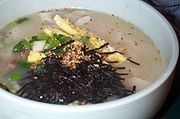
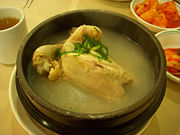
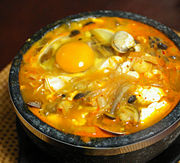
- GukGukGuk , also sometimes known as Tang , is a class of soup-like dishes in Korean cuisine. Guk and tang are commonly grouped together and regarded as the same type of dish, although guk is more watery and a basic dish for the Korean table setting, and is usually eaten at home...
(국), soup- Tteokguk (떡국), tteokTteokTteok is a class of Korean rice cakes made with glutinous rice flour , by steaming. Normal rice flour can be used for some kinds of tteok. There are hundreds of different kinds of tteok eaten year round...
(rice cake) soup - HaejanggukHaejanggukHaejangguk refers to all kinds of guk eaten as a hangover cure in Korean cuisine. It means "soup to chase a hangover" and also called sulguk in pure Korean...
(해장국): a favorite hangover cure consisting usually of meaty pork spine, dried ugeoji (우거지, dried outer leaves of Napa cabbageNapa cabbageNapa cabbage , also known as celery cabbage, is a type of Chinese cabbage originating near the Beijing region of China, and is widely used in East Asian cuisine. In much of the world, this is the vegetable referred to as "Chinese cabbage"...
or other vegetables), coagulated ox blood (similar to blood puddingBlood puddingBlood pudding may refer to either:*Black pudding, a sausage made with animal blood*Tiết canh, a North Vietnamese blood pudding*Blood Pudding, an icelandic dish...
), and vegetables in a hearty beef broth. - Miyeok gukMiyeok gukMiyeok guk is a Korean soup made from the sea vegetable miyeok. It comprises two words: miyeok, the Korean word for the sea vegetable; and guk, meaning "soup."...
(미역국), seaweed soup - MandugukManduguk-History:According to the 14th century records of Goryeosa , mandu had already been introduced via Central Asia during the Goryeo era. Mandu was called sanghwa or gyoja until the mid-Joseon Dynasty and became a local specialty of the Pyongan and Hamgyong regions, as both wheat and buckwheat - the...
, dumpling soup
- Tteokguk (떡국), tteok
- TangGukGuk , also sometimes known as Tang , is a class of soup-like dishes in Korean cuisine. Guk and tang are commonly grouped together and regarded as the same type of dish, although guk is more watery and a basic dish for the Korean table setting, and is usually eaten at home...
(탕), stew- GalbitangGalbitangGalbitang is a variety of guk, or Korean soup, made primarily from beef short ribs along with stewing beef, daikon, onions, and other ingredients. The short ribs, or "galbi" also refers to grilled short ribs in Korean barbecue while the suffix tang is another name for guk...
, a hearty soup made from short rib - OritangOritangOritang is a variety of guk, Korean soup or stew made by slowly simmering duck and various vegetables. Ori means "duck" and tang is another name for guk in Korean. While its recipe depends on region and taste, the soup is generally in a form of a clear soup...
, a soup or stew made by slowly simmering duckDuckDuck is the common name for a large number of species in the Anatidae family of birds, which also includes swans and geese. The ducks are divided among several subfamilies in the Anatidae family; they do not represent a monophyletic group but a form taxon, since swans and geese are not considered...
and various vegetables. - SamgyetangSamgyetangSamgyetang is a variety of guk or Korean soup, which primarily consists of a whole young chicken and Korean ginseng. The dish's name literally translates as "ginseng chicken soup" in English...
(삼계탕): a soup made with Cornish game hens that are stuffed with ginsengGinsengGinseng is any one of eleven species of slow-growing perennial plants with fleshy roots, belonging to the genus Panax of the family Araliaceae....
, hwanggi (황기, Astragalus propinquusAstragalus propinquusAstragalus propinquus also known as huáng qí or běi qí , huáng hua huáng qí , is a flowering plant in the family Fabaceae. It is one of the 50 fundamental herbs used in traditional Chinese medicine. It is a perennial plant and it is not listed as being threatened.- Herbalism :A...
), glutinous riceGlutinous riceGlutinous rice is a type of short-grained Asian rice that is especially sticky when cooked. It is called glutinous Glutinous rice (Oryza sativa var. glutinosa or Oryza glutinosa; also called sticky rice, sweet rice, waxy rice, botan rice, biroin chal, mochi rice, and pearl rice, and pulut) is a...
, jujubeJujubeZiziphus zizyphus , commonly called jujube , red date, Chinese date, Korean date, or Indian date is a species of Ziziphus in the buckthorn family Rhamnaceae, used primarily as a fruiting shade tree.-Distribution:Its precise natural distribution is uncertain due to extensive cultivation,...
s, garlic, and chestnuts. The soup is traditionally eaten in the summer. - SeolleongtangSeolleongtangSeolleongtang or Sul Lung Tang is a Korean broth soup made from ox bones , brisket and other cuts. Seasoning is generally done at the table according to personal taste by adding salt, ground black pepper, red pepper, minced garlic, or chopped spring onions...
(설렁탕): A beef bone stock is simmered overnight then served with thinly sliced pieces of beef. Usually served in a bowl containing dangmyeon (당면, cellophane noodlesCellophane noodlesCellophane noodles are a type of transparent noodle made from starch , and water.They are generally sold in dried form, boiled to reconstitute, then used in soups, stir fried dishes,...
s) and pieces of beef. Sliced scallionScallionScallions , are the edible plants of various Allium species, all of which are "onion-like", having hollow green leaves and lacking a fully developed root bulb.-Etymology:The words...
s and black pepperBlack pepperBlack pepper is a flowering vine in the family Piperaceae, cultivated for its fruit, which is usually dried and used as a spice and seasoning. The fruit, known as a peppercorn when dried, is approximately in diameter, dark red when fully mature, and, like all drupes, contains a single seed...
are used as condiments. - Maeuntang (매운탕): a refreshing, hot and spicy fish soup.
- GamjatangGamjatangGamjatang or pork bone soup is a spicy Korean soup made with pork spine, vegetables, green onions, hot peppers and ground wild sesame seeds. It is a matter of contention whether the name of the soup comes from the word for potato or not, because the soup is frequently served without potatoes.The...
(감자탕, "pork spine stew"): a spicy soup made with pork spine, vegetables (especially potatoes) and hot peppers. The vertebrae are usually separated. This is often served as a late night snack but may also be served for a lunch or dinner. - Daktoritang (닭도리탕) : A spicy chicken and potato stew. Also known as Dakbokkeumtang (닭볶음탕).
- Chueotang(추어탕)Live Loach soup, where the loach is alive right before it is dumped into the soup to be boiled alive to eat.
- Galbitang
- JjigaeJjigaeJjigae is a Korean dish similar to a Western stew. There are many different varieties but it is typically made with meat, seafood or vegetables in a broth seasoned with gochujang, doenjang, ganjang or saeujeot. Jjigae is typically served in a communal dish and boiling hot.A Korean meal almost...
(찌개), stew, formerly called "jochi" (조치) during the Joseon period- DoenjangDoenjangDoenjang is a traditional Korean fermented soybean paste. Its name literally means "thick paste" in Korean.-Production:...
jjigae (된장찌개): or soybean paste soup, is typically served as the main course or served alongside a meat course. It contains a variety of vegetables, shellfish, tofu, and occasionally small mussels, shrimp, and/or large anchovies. Usually, anchovies are used for preparing the base stock, and are taken out before adding the main ingredients. - CheonggukjangCheonggukjangCheonggukjang is a fermented soybean paste used in Korean cuisine. It contains whole as well as ground soybeans.- Production :It can be made in 2 to 3 days through fermentation of boiled soybeans, adding Bacillus subtilis, which is usually contained in the air or in the jip, dried rice plants,...
jjigae (청국장찌개): a soup made from strong-smelling thick soybean paste containing whole beans - GochujangGochujangGochujang is a savory and pungent fermented Korean condiment. Traditionally, it has been naturally fermented over years in large earthen pots outdoors, more often on an elevated stone platform, called jangdokdae in the backyard...
jjigae (고추장찌개): chili pepper paste soup - Kimchi jjigae (김치찌개): A soup made with mainly kimchi, pork, and tofu. It is a common lunch meal or compliment to a meat course. It is normally served in a stone pot, still boiling when it arrives at the table.
- Kongbiji jjiage: a stew made with ground soybeans.
- Sundubu jjigaeSundubu jjigaeSundubu jjigae is a hot and spicy jjigae dish made with uncurdled dubu , seafood , vegetables, mushrooms, onion, scallions, and gochujang or gochu garu in Korean cuisine. A raw egg is put in the jjigae while it is still boiling...
(순두부찌개): a spicy stew made with soft tofu and shellfish. Traditionally, the diner puts a raw eggEgg (food)Eggs are laid by females of many different species, including birds, reptiles, amphibians, and fish, and have probably been eaten by mankind for millennia. Bird and reptile eggs consist of a protective eggshell, albumen , and vitellus , contained within various thin membranes...
in it while it is still boiling. - SaeujeotSaeujeotSaeujeot is a variety of jeotgal, salted and fermented food made with small shrimp in Korean cuisine. It is the most consumed jeotgal along with myeolchijeot in South Korea. The name consists of the two Korean words, saeu and jeot...
jjigae (새우젓찌개), jjigae made with saeujeotSaeujeotSaeujeot is a variety of jeotgal, salted and fermented food made with small shrimp in Korean cuisine. It is the most consumed jeotgal along with myeolchijeot in South Korea. The name consists of the two Korean words, saeu and jeot...
(fermented shrimpShrimpShrimp are swimming, decapod crustaceans classified in the infraorder Caridea, found widely around the world in both fresh and salt water. Adult shrimp are filter feeding benthic animals living close to the bottom. They can live in schools and can swim rapidly backwards. Shrimp are an important...
sauce) - Budae jjigaeBudae jjigaeBudae jjigae is a type of jjigae . Soon after the Korean War, meat was scarce in Seoul, South Korea. Some people made use of surplus foods from U.S...
(부대찌개, lit. "army base stew"): Soon after the Korean WarKorean WarThe Korean War was a conventional war between South Korea, supported by the United Nations, and North Korea, supported by the People's Republic of China , with military material aid from the Soviet Union...
, meat was scarce in Seoul. Some people made use of surplus foods from US Army bases such as hot dogHot dogA hot dog is a sausage served in a sliced bun. It is very often garnished with mustard, ketchup, onions, mayonnaise, relish and/or sauerkraut.-History:...
s and canned ham (such as SpamSpam (food)Spam is a canned precooked meat product made by the Hormel Foods Corporation, first introduced in 1937. The labeled ingredients in the classic variety of Spam are chopped pork shoulder meat, with ham meat added, salt, water, modified potato starch as a binder, and sodium nitrite as a preservative...
) and incorporated it into a traditional spicy soup. This budae jjigae is still popular in South Korea, and the dish often incorporates more modern ingredients such as instant ramenRamenis a Japanese noodle dish. It consists of Chinese-style wheat noodles served in a meat- or fish-based broth, often flavored with soy sauce or miso, and uses toppings such as , , kamaboko, green onions, and occasionally corn...
noodles. - Saengseon jjige (생선찌개), fish stew
- Doenjang
- JeongolJeongolJeongol is a category of elaborate stews or casseroles in Korean cuisine. It is similar to the category of Korean stews called jjigae, with the main difference being that jjigae are generally made with only a single main ingredient, and named after that ingredient , while jeongol usually contain a...
(전골) : elaborate stew consisting of various ingredients. It is generally served on a burner.- SinseolloSinseolloSinseollo or yeolguja tang is an elaborate dish consisting of meatballs, small and round jeonyueo , mushrooms, and vegetables cooked in a rich broth in Korean royal court cuisine. The dish is a form of jeongol...
, elaborate variety of jeongol once served in Korean royal court cuisineKorean royal court cuisineKorean royal court cuisine was the style of cookery within Korean cuisine traditionally consumed at the court of the Joseon Dynasty, which ruled Korea from 1392 to 1910. There has been a revival of this cookery style in the 21st century...
. - Gopchang jeongolGopchang jeongolGopchang jeongol is a spicy Korean stew or casserole made by boiling beef tripe, vegetables, and seasonings in beef broth. Gopchang refers to small intestines of cattle or chitterlings, while jeongol refers to a category of stew or casserole in Korean cuisine...
, beef entrails and vegetable stew
- Sinseollo
Grain dishes
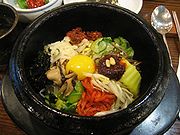
- BibimbapBibimbapBibimbap is a signature Korean dish. The word literally means "mixed meal." Bibimbap is served as a bowl of warm white rice topped with namul and gochujang . A raw or fried egg and sliced meat are common additions. The ingredients are stirred together thoroughly just before eating...
(비빔밥, "mixed rice"): rice topped with seasoned vegetables such as spinachSpinachSpinach is an edible flowering plant in the family of Amaranthaceae. It is native to central and southwestern Asia. It is an annual plant , which grows to a height of up to 30 cm. Spinach may survive over winter in temperate regions...
, mushroomMushroomA mushroom is the fleshy, spore-bearing fruiting body of a fungus, typically produced above ground on soil or on its food source. The standard for the name "mushroom" is the cultivated white button mushroom, Agaricus bisporus; hence the word "mushroom" is most often applied to those fungi that...
s, sea tangle, carrotCarrotThe carrot is a root vegetable, usually orange in colour, though purple, red, white, and yellow varieties exist. It has a crisp texture when fresh...
s, bean sprouts, and served with a dollop of gochujangGochujangGochujang is a savory and pungent fermented Korean condiment. Traditionally, it has been naturally fermented over years in large earthen pots outdoors, more often on an elevated stone platform, called jangdokdae in the backyard...
(red pepper paste), and variations often include beef and/or egg. Everything (seasonings, rice and vegetables) is stirred together in one large bowl and eaten with a spoon. One popular variation of this dish, dolsot bibimbap (돌솥 비빔밥), is served in a heated stone bowl, which permits the dish to continue cooking after it is served, and in which a raw egg is cooked against the sides of the bowl. Yukhoe bibimbap(육회비빔밥) is another variant of bibimbap, comprising raw beef strips with raw egg and a mixture of soy sauce with Asian pear and gochujang. HoedeopbapHoedeopbapHoedeopbap is a Korean dish consisting of steamed rice mixed with sliced or cubed saengseon hoe , various vegetables such as lettuce, cucumber and sesame leaves, sesame oil, and chogochujang...
(회덮밥) is another variation of bibimbap using a variety of cubed raw fish. - Boribap (보리밥): Barley cooked rice
- NurungjiNurungjiNurungji is a traditional Korean food made of scorched rice. After boiling and serving rice, a thin crust of scorched rice will usually be left in the bottom of the cooking pot...
: The crisp thin layer of rice left on the bottom of the pot when cooking rice which is eaten as a snack. - OgokbapOgokbapOgokbap or five-grains rice is a kind of Korean food made of a bowl of steamed rice mixed with grains including barley, foxtail millet, millet and soy beans. Ogokbap usually served during the end of winter, especially on the first full moon of the year...
(오곡밥, five-grain rice): Usually a mixture of rice, red beans, black beans, millet, and sorghum, but can vary with glutinous riceGlutinous riceGlutinous rice is a type of short-grained Asian rice that is especially sticky when cooked. It is called glutinous Glutinous rice (Oryza sativa var. glutinosa or Oryza glutinosa; also called sticky rice, sweet rice, waxy rice, botan rice, biroin chal, mochi rice, and pearl rice, and pulut) is a...
and other grains in place of these. - Patbap: rice with red beans
- Kongnamulbap: rice with bean sprouts kongnamulKongnamulKongnamul, an example of Korean cuisine, refers to a seasoned banchan made from soybean sprouts, as well as being a term for the sprouts themselves in the Korean language...
and sometimes pork - Kimchi bokkeumbapKimchi bokkeumbapKimchi bokkeumbap is a variety of bokkeumbap , a popular dish in South Korea. Its name literally translates as "Kimchi fried rice"...
: kimchiKimchiKimchi , also spelled gimchi, kimchee, or kim chee, is a traditional fermented Korean dish made of vegetables with varied seasonings. There are hundreds of varieties of kimchi made with a main vegetable ingredient such as napa cabbage, radish, green onions or cucumber. It is the most common...
fried rice with typically chopped vegetables and meats
Banchan (side dishes)
- KimchiKimchiKimchi , also spelled gimchi, kimchee, or kim chee, is a traditional fermented Korean dish made of vegetables with varied seasonings. There are hundreds of varieties of kimchi made with a main vegetable ingredient such as napa cabbage, radish, green onions or cucumber. It is the most common...
(김치): vegetables (usually cabbageCabbageCabbage is a popular cultivar of the species Brassica oleracea Linne of the Family Brassicaceae and is a leafy green vegetable...
, white radishRadishThe radish is an edible root vegetable of the Brassicaceae family that was domesticated in Europe, in pre-Roman times. They are grown and consumed throughout the world. Radishes have numerous varieties, varying in size, color and duration of required cultivation time...
, or cucumberCucumberThe cucumber is a widely cultivated plant in the gourd family Cucurbitaceae, which includes squash, and in the same genus as the muskmelon. The plant is a creeping vine which bears cylindrical edible fruit when ripe. There are three main varieties of cucumber: "slicing", "pickling", and...
) commonly fermentFermentation (food)Fermentation in food processing typically is the conversion of carbohydrates to alcohols and carbon dioxide or organic acids using yeasts, bacteria, or a combination thereof, under anaerobic conditions. Fermentation in simple terms is the chemical conversion of sugars into ethanol...
ed in a brine of gingerGingerGinger is the rhizome of the plant Zingiber officinale, consumed as a delicacy, medicine, or spice. It lends its name to its genus and family . Other notable members of this plant family are turmeric, cardamom, and galangal....
, garlicGarlicAllium sativum, commonly known as garlic, is a species in the onion genus, Allium. Its close relatives include the onion, shallot, leek, chive, and rakkyo. Dating back over 6,000 years, garlic is native to central Asia, and has long been a staple in the Mediterranean region, as well as a frequent...
, green onionOnionThe onion , also known as the bulb onion, common onion and garden onion, is the most widely cultivated species of the genus Allium. The genus Allium also contains a number of other species variously referred to as onions and cultivated for food, such as the Japanese bunching onion The onion...
and chilli pepper. There are endless varieties, and it is served as a side dish or cooked into soups and rice dishes. Koreans traditionally make enough kimchi to last for the entire winter season, although with refrigerators and commercial bottled kimchi this practice has become less common. KimchiKimchiKimchi , also spelled gimchi, kimchee, or kim chee, is a traditional fermented Korean dish made of vegetables with varied seasonings. There are hundreds of varieties of kimchi made with a main vegetable ingredient such as napa cabbage, radish, green onions or cucumber. It is the most common...
is often cited for its health benefits and has been included in Health magazine's "World's Healthiest Foods". Nonetheless, some research has found nitrate and salt levels in Kimchi to be possible risk factors to gastric cancer although shellfish and fruit consumption were found to be protective factors to gastric cancer. Interestingly research has also found kimchi to be a preventive factor to stomach cancer.- GgakdugiGgakdugiKkakdugi is a variety of kimchi in Korean cuisine. Usually, it has all the ingredients of kimchi, but the baechu used for kimchi is substituted with Korean white radish...
, radish kimchi - Baek kimchiBaek kimchiBaek kimchi is a variety of kimchi made without the chili pepper powder commonly used for pickling kimchi in Korean cuisine. Baek kimchi has a mild and clean flavor, which appeals to children and the elderly, to whom the regular kimchi might be too spicy...
, kimchi made without chili pepper - Mulkimchi, literally water kimchi
- Nabak kimchiNabak kimchiNabak kimchi is a watery kimchi, similar to dongchimi, in Korean cuisine. It is made of thinly sliced Korean white radish and Napa cabbage into a rectangular shape as main ingredients and salted them with mixed vegetables and spices such as cucumber, spring onions, water dropwort , garlic, ginger,...
, - DongchimiDongchimiDongchimi is a variety of kimchi consisting of daikon, baechu , spring onions, fermented green chili, ginger, bae and watery brine in Korean cuisine...
- Nabak kimchi
- Pakimchi, scallion kimchi
- Buchukimchi
- Oisobakki, cucumber kimchi
- Kkaetnip kimchi, perllia leaf kimchi
- Chonggak kimchi, kimchi made with pony tail radish
- Ggakdugi
- NamulNamulNamul is a general term for a Korean seasoned vegetable dish. The name of the dish may vary slightly depending on what vegetables are used and how they are prepared, but they will nonetheless still be a type of namul....
- KongnamulKongnamulKongnamul, an example of Korean cuisine, refers to a seasoned banchan made from soybean sprouts, as well as being a term for the sprouts themselves in the Korean language...
(콩나물): Soybean sprouts, usually eaten in boiled and seasoned banchan. Soybean sprouts are also the main ingredient in kongnamul-bap (sprouts over rice), kongnamul-guk (sprout soup), and kongnamul-gukbap (rice in sprout soup). - ChwinamulChwinamulChwinamul is a Korean leaf vegetable. It consists of the leaves of various species of wild flowering plants, including Aster scaber. There are approximately 24 edible varieties in Korea of which most are found on mountains...
- Kongnamul
GuksuGuksuThe Guksu is a Go competition in South Korea.-Outline:The Guksu is a Go competition held by the Hanguk Kiwon, and sponsored by The Dong-a Ilbo. It is the longest running competition in South Korea...
/ noodles
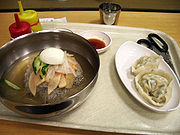
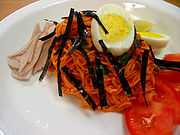
- NaengmyeonNaengmyeonNaengmyeon is a Korean dish of long and thin hand-made noodles made from the flour and starch of various ingredients: buckwheat , potatoes, sweet potatoes, 칡냉면, naengmyun made with the starch from arrowroot , and kudzu...
(냉면, (North KoreaNorth KoreaThe Democratic People’s Republic of Korea , , is a country in East Asia, occupying the northern half of the Korean Peninsula. Its capital and largest city is Pyongyang. The Korean Demilitarized Zone serves as the buffer zone between North Korea and South Korea...
: 랭면, Raengmyŏn), "cold noodles"): this dish (or originally winter dish) consists of several varieties of thin, hand-made buckwheatBuckwheatBuckwheat refers to a variety of plants in the dicot family Polygonaceae: the Eurasian genus Fagopyrum, the North American genus Eriogonum, and the Northern Hemisphere genus Fallopia. Either of the latter two may be referred to as "wild buckwheat"...
noodleNoodleThe noodle is a type of food, made from any of a variety of doughs, formed into long thin ribbons, strips, curly-cues, waves, helices, pipes, tubes, strings, or other various shapes, sometimes folded. They are usually cooked in a mixture of boiling water and/or oil. Depending upon the type, noodles...
s, and is served in a large bowl with a tangy iced broth, raw julienned vegetables and fruit, and often a boiled egg and cold cooked beef. This is also called Mul ("water") Naengmyeon, to distinguish Bibim Naengmyeon, which has no broth and is mixed with gochujang. - JapchaeJapchaeJapchae is a Korean dish made from sweet potato noodles , stir fried in sesame oil with various vegetables , sometimes served with beef, and flavoured with soy sauce, and sweetened with sugar...
(잡채): Boiled dangmyeon or potato noodles, steamed spinach, roasted julienned beef, roasted sliced onion, roasted julienned carrots are mixed with seasoning made of soy sauce, sesame oil and half-refined sugar. - JajangmyeonJajangmyeonJajangmyeon is a popular Korean dish, derived from the Chinese dish zha jiang mian. It consists of wheat noodles topped with a thick sauce made of chunjang , diced meat and vegetables, and sometimes also seafood...
(자장면): A variation on a ChineseChinese cuisineChinese cuisine is any of several styles originating in the regions of China, some of which have become highly popular in other parts of the world – from Asia to the Americas, Australia, Western Europe and Southern Africa...
noodle dish that is extremely popular in Korea. It is made with a black bean sauce, usually with some sort of meat and a variety of vegetables including zucchini and potatoes. Usually ordered and delivered, like pizza. - KalguksuKalguksuKalguksu is a Korean noodle dish consisting of handmade, knife-cut wheat flour noodles served in a large bowl with broth and other ingredients. It is traditionally considered a seasonal food, consumed most often in summer...
(칼국수): boiled flat noodleNoodleThe noodle is a type of food, made from any of a variety of doughs, formed into long thin ribbons, strips, curly-cues, waves, helices, pipes, tubes, strings, or other various shapes, sometimes folded. They are usually cooked in a mixture of boiling water and/or oil. Depending upon the type, noodles...
s, usually in a broth made of anchoviesAnchovyAnchovies are a family of small, common salt-water forage fish. There are 144 species in 17 genera, found in the Atlantic, Indian, and Pacific Oceans. Anchovies are usually classified as an oily fish.-Description:...
and sliced zucchiniZucchiniThe zucchini is a summer squash which often grows to nearly a meter in length, but which is usually harvested at half that size or less. It is a hybrid of the cucumber. Along with certain other squashes, it belongs to the species Cucurbita pepo. Zucchini can be dark or light green...
. - SujebiSujebiSujebi or milgaru ddeudeo guk is a Korean traditional soup consisting of dough flakes roughly torn by hand, with various vegetables. The flavor and recipe resemble kalguksu, except that the latter is made with noodles rather than wheat flakes...
(수제비) - MakguksuMakguksuMakguksu is a Korean buckwheat noodle dish served in a chilled broth. It is a local specialty of the Gangwon province of South Korea, and its capital city, Chuncheon.-Ingredients and preparation:...
(막국수), buckwheat noodles - Jaengban guksu (쟁반국수)
- Bibim guksu (비빔국수), stirred noodles in a hot and spicy sauce
- Ramyeon (라면): spicy variation of noodle, usually people eat instant Ramyeon.
- Janchi guksuJanchi guksuJanchi guksu is a Korean noodle dish consisting of wheat flour noodles in a light broth made from anchovy and sometimes also dasima . Beef broth may be substituted for the anchovy broth. It is served with a sauce made from sesame oil, ganjang, and small amounts of chili pepper powder and scallions...
(잔치국수): a light seaweed broth based noodle soup served with fresh condiments, usually kimchi, thinly sliced egg, green onions, and cucumbers. - Geonjin guksu (건진국수)
Gimbap

Gimbap
Gimbap or kimbap is a popular Korean dish made from steamed white rice and various other ingredients, rolled in gim and served in bite-size slices...
(literally, seaweed-rice, 김밥) is a very popular snack in Korea. It consists of cooked rice, sesame oil
Sesame oil
Sesame oil is an edible vegetable oil derived from sesame seeds. Besides being used as a cooking oil in South India, it is often used as a flavor enhancer in Chinese, Japanese, Korean, and to a lesser extent Southeast Asian cuisine.The oil from the nutrient rich seed is popular in alternative...
, salt, and sesame seeds, to which small amounts of vinegar and sugar are often added as seasonings. Then it is placed on a sheet of gim, dried laver
Laver (seaweed)
Laver is an edible algae often considered to be a seaweed that has a high mineral salt content, particularly iodine and iron. It is used for making laverbread, a traditional Welsh dish. Laver is common around the west coast of Britain and east coast of Ireland along the Irish Sea.It is smooth and...
. The seasoned rice is spread on the laver, and then fried egg, julienned carrots, julienned ham, seasoned ground beef or seasoned fish cakes, pickled radish, seasoned spinach, and seasoned gobo and cucumber are then placed closely together on the rice, and is rolled in the manner similar to that of the Japanese sushi
Sushi
is a Japanese food consisting of cooked vinegared rice combined with other ingredients . Neta and forms of sushi presentation vary, but the ingredient which all sushi have in common is shari...
. Today, there are many varieties of gimbap: tuna, cheese, bulgogi, vegetable, and more.
Jeon
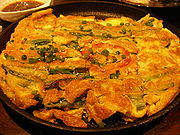
Jeon
Jeon (food)
Jeon , buchimgae, jijimgae, or jijim refer to many pancake-like dishes in Korean cuisine. It has been also called jeonyueo or jeonyuhwa, especially in Korean royal court cuisine. Sometimes, jeonya is used as an abbreviated term for the two...
is a Korean pancake like dish. Fermented kimchi
Kimchi
Kimchi , also spelled gimchi, kimchee, or kim chee, is a traditional fermented Korean dish made of vegetables with varied seasonings. There are hundreds of varieties of kimchi made with a main vegetable ingredient such as napa cabbage, radish, green onions or cucumber. It is the most common...
(kimchijeon) or seafood
Seafood
Seafood is any form of marine life regarded as food by humans. Seafoods include fish, molluscs , crustaceans , echinoderms . Edible sea plants, such as some seaweeds and microalgae, are also seafood, and are widely eaten around the world, especially in Asia...
(haemul pajeon
Pajeon
Pajeon is a variety of jeon with green onions as its prominent ingredient. Pa literally means green onion in Korean. It is a pancake-like Korean dish made from a batter of eggs, flour, rice flour, green onions and other additional ingredients depending on the variety...
) is mixed into a flour-based batter, and then fried in an oiled pan. This dish tastes best when it is dipped in a mixture of soy sauce, vinegar, and chili pepper powder.
- PajeonPajeonPajeon is a variety of jeon with green onions as its prominent ingredient. Pa literally means green onion in Korean. It is a pancake-like Korean dish made from a batter of eggs, flour, rice flour, green onions and other additional ingredients depending on the variety...
(파전): pancake made mostly with eggs, flour, green onion, and oysters or fresh baby clams cooked in a frying pans - BindaetteokBindaetteokBindaetteok is a variety of jeon, a Korean style pancake...
(빈대떡): pancake made of ground mung beans, green onions, and kimchi or peppers cooked in a frying pan - Kimchi jeonKimchi JeonKimchijeon or kimchi jeon is a variety of jeon, or Korean pancake-like dish, primarily made with sliced kimchi, flour batter and sometimes other vegetables. However, meat and fish are also often added. Kimchi, spicy pickled vegetables seasoned with chili pepper and jeotgal, is a staple in Korean...
(김치전) - Mineojeon (민어전 民魚煎), made with croaker
- Daegujeon (대구전 大口煎), made with Pacific cod
- Guljeon (굴전), made with oyster
- Hobakjeon (호박전), made with squash
- Yeongeunjeon (연근전), made with lotus root
- Gochujeon (고추전), made with chili peppers
- Dubujeon (두부전), made with tofu
- Pyogojeon (표고전), made with shiitakeShiitakeThe Shiitake is an edible mushroom native to East Asia, which is cultivated and consumed in many Asian countries, as well as being dried and exported to many countries around the world. It is a feature of many Asian cuisines including Vietnamese, Chinese, Japanese, Korean and Thai...
mushrooms and beef
Other snacks
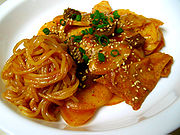
- Ddeokbokki (떡볶이): a casserole dish which is made with sliced rice cake, seasoned beef, fish cakes, and vegetables. It is flavored with gochujangGochujangGochujang is a savory and pungent fermented Korean condiment. Traditionally, it has been naturally fermented over years in large earthen pots outdoors, more often on an elevated stone platform, called jangdokdae in the backyard...
. - SoondaeBlood sausageBlack pudding, blood pudding or blood sausage is a type of sausage made by cooking blood or dried blood with a filler until it is thick enough to congeal when cooled. The dish exists in various cultures from Asia to Europe...
(순대): Korean sausage made with a mixture of boiled sweet rice, oxen or pig's blood, potato noodle, mung bean sprouts, green onion and garlic stuffed in a natural casing. - HotteokHotteokHotteok is a variety of filled Korean pancake, and is a popular street food of South Korea. It is usually eaten during the winter season.-Preparation:...
(호떡) : similar to pancakePancakeA pancake is a thin, flat, round cake prepared from a batter, and cooked on a hot griddle or frying pan. Most pancakes are quick breads; some use a yeast-raised or fermented batter. Most pancakes are cooked one side on a griddle and flipped partway through to cook the other side...
s, but the syrup is in the filling rather than a condiment. Melted brown sugar, honey, chopped peanuts and cinnamonCinnamonCinnamon is a spice obtained from the inner bark of several trees from the genus Cinnamomum that is used in both sweet and savoury foods...
are common fillings. Vegetables are sometimes added to the batter. Hotteok is usually eaten during the winter months to "warm up" the body with the sweet and warm syrup in the pancake. - HobbangHobbangHobbang is a hot snack sold throughout South Korea. It is a pre-cooked ball of rice flour filled with something such as red bean paste, similar to Chinese Doushabao...
(호빵) - BeondegiBeondegiBeondegi are a popular snack food in Korean cuisine. Literally meaning "chrysalis" or "pupa" in Korean, Beondegi are steamed or boiled silkworm pupae which are seasoned and eaten as a snack. Beondegi are often served by street vendors, as well as in restaurants and drinking establishments...
(번데기) : is steamed or boiled silkworm pupae which are seasoned and eaten as a snack. - BungeoppangBungeoppangBungeoppang is the Korean name of a pastryBungeoppangs are made using an appliance similar to a waffle iron. The batter is poured into a fish-shaped mold, red bean paste is added, then more batter to encase the red bean paste...
(붕어빵; "carp-bread") is the Korean name for the Japanese fish-shaped pastry Taiyaki that is usually filled with sweet red bean pasteRed bean pasteRed bean paste or Azuki bean paste is a sweet, dark red bean paste originating from China. It is used in Chinese cuisine, Japanese confectionery, and Korean cuisine. It is prepared by boiling and mashing azuki beans and then sweetening the paste with sugar or honey...
and then baked in a fish-shaped mold. It is very chewy on the inside and crispy on the outside. Gukwa-ppang (국화빵) is almost the same as bungeoppang, but it is shaped like a flower. Gyeran-ppang (계란빵, egg bread) has a shape of rounded rectangle and contains whole egg inside of a bread. They are often sold by street vendors. (See also taiyakiTaiyakiis a Japanese fish-shaped cake. The most common filling is red bean paste that is made from sweetened azuki beans. Other common fillings may be custard, chocolate, or cheese. Some shops even sell taiyaki with okonomiyaki, gyoza filling, or a sausage inside....
.)
Anju (side dishes accompanying alcoholic beverages)
- AnjuAnju (food)Anju is a general term for a Korean side dish consumed with alcohol . Some of these side dishes can also be ordered as an appetizer or a main dish. These side dishes are different from the banchan side dishes served with a regular Korean meal...
(안주) is a general term for a Korean side dish consumed with alcohol (often with Korean sojuSojuSoju is a distilled beverage native to Korea. Its taste is comparable to vodka, though often slightly sweeter due to sugars added in the manufacturing process, and more commonly consumed neat.Most brands of soju are made in South Korea...
). It is commonly served at bars, NoraebangKaraoke BoxA is a common type of karaoke establishment commonly found in Japan. Karaoke boxes consist of multiple rooms containing karaoke equipment, usually rented out for time periods. A typical karaoke box establishment contains 10-20 such rooms as well as a main karaoke bar area in the front...
(karaoke) establishments, and restaurants that serve alcohol. These side dishes can also be ordered as appetizers or even a main dish. Some examples of anju include steamed squid with gochujangGochujangGochujang is a savory and pungent fermented Korean condiment. Traditionally, it has been naturally fermented over years in large earthen pots outdoors, more often on an elevated stone platform, called jangdokdae in the backyard...
, assorted fruit, dubu kimchiDubu kimchiDubu kimchi is a Korean dish consisting of sauteed kimchi served with tofu. Boiled or pan-fried sliced tofu and the kimchi are often served with sliced pork or canned tuna...
(tofu with kimchi), peanuts, odenOdenOden is a Japanese winter dish consisting of several ingredients such as boiled eggs, daikon radish, konnyaku, and processed fish cakes stewed in a light, soy-flavoured dashi broth. Ingredients vary according to region and between each household...
g/ohmuk, gimbapGimbapGimbap or kimbap is a popular Korean dish made from steamed white rice and various other ingredients, rolled in gim and served in bite-size slices...
(small or large), samgagimbap (triangle-shaped gimbap like the Japanese onigiriOnigiri, also known as or rice ball, is a Japanese food made from white rice formed into triangular or oval shapes and often wrapped in nori . Traditionally, an onigiri is filled with pickled ume , salted salmon, katsuobushi, kombu, tarako, or any other salty or sour ingredient as a natural preservative...
), sora (소라 (a kind of shellfish popular in street food tents), and nakji (small octopus, as eaten on screen in the movie OldboyOldboyOldboy is a 2003 South Korean film directed by Park Chan-wook. It is based on the Japanese manga of the same name written by Nobuaki Minegishi and Garon Tsuchiya. Oldboy is the second installment of The Vengeance Trilogy, preceded by Sympathy for Mr...
). Soondae is also a kind of anju, as is samgyeopsal, or dwejigalbi. Most Korean foods may be served as anju, depending on availability and the diner's taste. However, anju are considered different from the banchanBanchanBanchan refers to small dishes of food served along with cooked rice in Korean cuisine. This word is used both in the singular and plural....
side dishes served with a regular Korean meal. - JokbalJokbalJokbal is a Korean dish consisting of pigs' feet cooked with soy sauce and spices.-Preparation:The hair is removed from pigs' feet and they are thoroughly washed. Leeks, garlic, ginger, cheongju and water are brought to a boil. The pigs' feet are added, brought back to a boil and then simmered...
(족발): pig's feet served with a red salted shrimp sauce called saeujeotSaeujeotSaeujeot is a variety of jeotgal, salted and fermented food made with small shrimp in Korean cuisine. It is the most consumed jeotgal along with myeolchijeot in South Korea. The name consists of the two Korean words, saeu and jeot...
.
Desserts
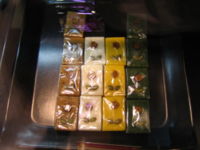
- TteokTteokTteok is a class of Korean rice cakes made with glutinous rice flour , by steaming. Normal rice flour can be used for some kinds of tteok. There are hundreds of different kinds of tteok eaten year round...
(떡): a chewy cake made from either pounded short-grain rice (메떡, metteok), pounded glutinous rice (찰떡, chaltteok), or glutinous riceGlutinous riceGlutinous rice is a type of short-grained Asian rice that is especially sticky when cooked. It is called glutinous Glutinous rice (Oryza sativa var. glutinosa or Oryza glutinosa; also called sticky rice, sweet rice, waxy rice, botan rice, biroin chal, mochi rice, and pearl rice, and pulut) is a...
left whole, without pounding (약식, yaksik). It is served either cold (filled or covered with sweetened mung beanMung beanThe mung bean is the seed of Vigna radiata. It is native to the Indian subcontinent.-Description:They are small, ovoid in shape, and green in color...
paste, red-bean paste, raisins, a sweetened filling made with sesame seeds, mashed red beansAzuki beanThe is an annual vine, Vigna angularis, widely grown throughout East Asia and the Himalayas for its small bean. The cultivars most familiar in north-east Asia have a uniform red color, but white, black, gray and variously mottled varieties are also known. Scientists presume Vigna angularis var...
, sweet pumpkin, beans, dates, pine nuts, and/or honey), usually served as dessert or snack. Sometimes cooked with thinly sliced beef, onions, oyster mushrooms, etc. to be served as a light meal.- SongpyeonSongpyeonSongpyeon is a traditional Korean food made of glutinous rice. It is a variation of tteok, consisting of small rice cakes traditionally eaten during the Korean autumn harvest festival, Chuseok. They have become a popular symbol of traditional Korean culture...
(송편): chewy stuffed tteok (rice cake) served at Chuseok (Mid-Autumn FestivalMid-Autumn FestivalThe Mid-Autumn Festival , also known as the Moon Festival or Mooncake Festival or Zhongqiu Festival, is a popular lunar harvest festival celebrated by Chinese and Vietnamese people. A description of the festival first appeared in Rites of Zhou, a written collection of rituals of the Western Zhou...
) decorated with pinePinePines are trees in the genus Pinus ,in the family Pinaceae. They make up the monotypic subfamily Pinoideae. There are about 115 species of pine, although different authorities accept between 105 and 125 species.-Etymology:...
needle. HoneyHoneyHoney is a sweet food made by bees using nectar from flowers. The variety produced by honey bees is the one most commonly referred to and is the type of honey collected by beekeepers and consumed by humans...
or another soft sweet material, or red beanRed beanRed bean may refer to:* Azuki bean, commonly used in Japanese and Chinese cuisine, particularly as red bean paste* Kidney bean, commonly used in Indian and North American cuisine, such as chili con carne and red beans and rice...
is found inside. - YakshikYakshikYaksik or yakbap is a sweet Korean dish made by steaming glutinous rice, and mixing with chestnuts, jujubes, and pine nuts. It is seasoned with honey or brown sugar, sesame oil, soy sauce, and sometimes cinnamon...
(약식) is a dessert made with glutinous rice, chestnuts, pine nuts, jujubes, and raw sugar and soy sauceSoy sauceSoy sauce is a condiment produced by fermenting soybeans with Aspergillus oryzae or Aspergillus sojae molds, along with water and salt...
and then steamed for seven to eight hours or until the mixture turns a blackish color. some recipes call for topping the cooked mixture with persimmonPersimmonA persimmon is the edible fruit of a number of species of trees in the genus Diospyros in the ebony wood family . The word Diospyros means "the fire of Zeus" in ancient Greek. As a tree, it is a perennial plant...
s. - ChapssaltteokChapssaltteokChapssaltteok is a Korean dessert that consists of rice cakes filled with sweet bean paste. The cakes themselves are made from either pounded rice , pounded glutinous rice , or glutinous rice left whole, without pounding . It is a variant of tteok and is similar to Japanese mochi....
(찹쌀떡): a variety of tteok filled with sweet bean pasteSweet bean pasteSweet bean paste is a food ingredient used in several Asian cuisines. Within Chinese cuisine, it is primarily used as a filling for sweet desserts and Chinese pastry.- Production :...
. Similar to Japanese mochi.
- Songpyeon
Types of non-alcoholic beverages
- Insam cha (인삼차) - Korean ginsengGinsengGinseng is any one of eleven species of slow-growing perennial plants with fleshy roots, belonging to the genus Panax of the family Araliaceae....
tea - Saenggang cha (생강차) - Tea made from gingerGingerGinger is the rhizome of the plant Zingiber officinale, consumed as a delicacy, medicine, or spice. It lends its name to its genus and family . Other notable members of this plant family are turmeric, cardamom, and galangal....
root. - SujeonggwaSujeonggwaSujeonggwa is a Korean traditional fruit punch. Dark reddish brown in color, it is made from dried persimmons, cinnamon, ginger, peppercorn and is often garnished with pine nuts. The punch is made by brewing first the cinnamon, ginger and peppercorn at a slow boil...
(수정과) - dried persimmonPersimmonA persimmon is the edible fruit of a number of species of trees in the genus Diospyros in the ebony wood family . The word Diospyros means "the fire of Zeus" in ancient Greek. As a tree, it is a perennial plant...
punch - SikhyeSikhyeSikhye is a traditional sweet Korean rice beverage, usually served as a dessert...
(식혜) - sweet rice beverage - YujachaYujachaYujacha or yuja cha is a traditional Korean tea made from citron. Yuja fruit is thinly sliced with its peel and combined with honey or sugar, prepared as fruit preserves...
(유자차) - citronYuzuThe yuzu is a citrus fruit and plant originating in East Asia. It is believed to be a hybrid of sour mandarin and Ichang papeda...
tea - Bori cha (보리차) - roasted barleyBarleyBarley is a major cereal grain, a member of the grass family. It serves as a major animal fodder, as a base malt for beer and certain distilled beverages, and as a component of various health foods...
tea - Oksusu chaOksusu chaOksusu cha is a traditional Korean tisane made from boiled roasted corn kernels.The variety of corn most often used is called Gang-naeng-i , which is usually grown in the area of Gangneung, a city in the Gangwon province on South Korea's eastern coast, thus making this drink particularly popular...
(옥수수차) - roasted cornMaizeMaize known in many English-speaking countries as corn or mielie/mealie, is a grain domesticated by indigenous peoples in Mesoamerica in prehistoric times. The leafy stalk produces ears which contain seeds called kernels. Though technically a grain, maize kernels are used in cooking as a vegetable...
tea - Hyeonmi chaHyeonmi chaHyeonmi cha is a tisane made from roasted brown rice.To make hyeonmi cha, brown rice is washed, then roasted in a pot. Then water is poured into the pot, brought to a boil, and then simmered for approximately ten minutes...
(현미차) - roasted brown rice tea - SungnyungSungnyungSungnyung is a traditional Korean beverage made from boiled scorched rice.This drink is typically made from nurungji, the roasted crust of rice that forms on the bottom of a pot after cooking rice...
(숭늉) - beverage made from boiled scorched rice - Yulmucha (율무차) - Job's tearsJob's TearsJob's Tears , Coixseed, Tear Grass, adlay, or adlai, is a tall grain-bearing tropical plant of the family Poaceae native to Southeast Asia but elsewhere cultivated in gardens as an annual. It has been naturalized in the southern United States and the New World tropics...
tea - Gyeolmyeongja cha (결명자차, 決明子茶) - made from roasted Senna obtusifoliaSenna obtusifoliaSenna obtusifolia is a legume in the genus Senna, sometimes separated in the monotypic genus Diallobus. It grows wild in North, Central, and South America, Asia, Africa, and Oceania, and is considered a particularly serious weed in many places...
seeds - MisuMisuMisu is a kind of Korean traditional drink made of grain powder. It is usually served in the hot summer days to quench thirst and also as an instant nutritious drink fulfilling the lost energy because of heat....
(미수, 米水) - several grains such as rice, barley, beans, glutinous rice, brown rice, Job's tearsJob's TearsJob's Tears , Coixseed, Tear Grass, adlay, or adlai, is a tall grain-bearing tropical plant of the family Poaceae native to Southeast Asia but elsewhere cultivated in gardens as an annual. It has been naturalized in the southern United States and the New World tropics...
, etc. are roasted and then ground to be added to water. - SungnyungSungnyungSungnyung is a traditional Korean beverage made from boiled scorched rice.This drink is typically made from nurungji, the roasted crust of rice that forms on the bottom of a pot after cooking rice...
(숭늉): The remains of the rice removed from the pot mixed with water and boiled into a soup.

